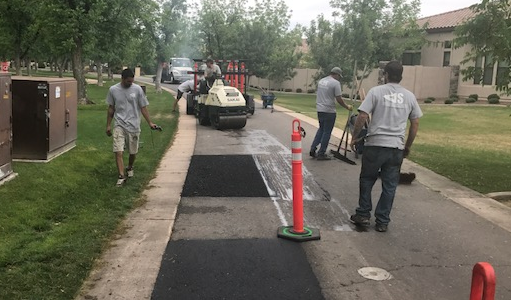Infrared Asphalt Repair
Asphalt Crack Repairs and Parking Lot Resurfacing in Scottsdale, Arizona
1. How does the infrared heat repair process work?
It works by heating asphalt to 300 degrees. The asphalt is then recycled and repaired on site. At 300 degrees F, the heated asphalt is broken down to its original granular form. Then, oils and bonding agents are added to bring the asphalt back to new condition. The asphalt is then raked and leveled out to remove any cracks or potholes. Finally, the repair is compacted, and the edges are fused with the existing asphalt, creating one continuous layer, as it was when it was new.
2. Is this process proven?
The equipment and process been on the market for over 15 years and has been tested, improved upon, perfected and proven. The infrared heat process has become the preferred method for repairing asphalt for many states, municipalities, developers and property owners throughout the country and is well on its way to becoming the preferred standard throughout the industry.
3. This process of fusing the repair with the existing asphalt sounds high tech.
It sounds high-tech, but it's based on simple fundamentals. Asphalt heated to 300 degrees F brings it back to its original state.
4. Why is infrared asphalt repair solution better than the saw cut method?
The perimeter of every saw cut repair is outlined by a large cut that goes straight through to the road base. In this scenario, you have a crack the moment the repair is completed. These saw cut cracks would need to be fixed immediately, maintained and filled every couple of years. So, your costs continue to mount. Eventually, this filler dries out and opens up allowing even more destructive elements back into your asphalt. The infrared process gives a seamless repair of one continuous layer of asphalt. As a result, there are no saw cuts to crack fill and no expensive ongoing maintenance.
5. What's the problem with just having my damaged areas crack filled?
When an area has cracked heavily into an expansive network of cracks, it's impossible to seal every crack. Additionally, when outside temperatures escalate, traffic from vehicle tires will lift the crack fill and break its bond. Eventually, the crack filler dries out and will crack again, so it needs to be re-done every two years or so causing on-going maintenance and additional expenses.
As long as you have traffic over these areas, you will see the damage grow consistently. Because the asphalt was never repaired and it is broken into separate pieces, the strength and integrity of the asphalt are compromised. As vehicles drive over the weakened asphalt, it continues to crack and break into additional pieces, further compromising the structural integrity of the asphalt.
6. I've heard that infrared heat solution only repairs the top inch of asphalt, so cracks below that one inch will work their way back to the surface and reappear. Is this true?
Bad practices, poor equipment, and poor quality standards are not a true reflection of the infrared heat process. In any service industry, there are companies that do a poor job. They focus on speed and quantity rather than focusing on quality. Infrared Solutions has the best equipment on the market and has established a set of best practices and standards for every job we do. This includes an ongoing quality assurance check, ensuring that we are consistently getting 2.5 inches or more of depth to our repairs.
7. I've heard with a saw cut repair that the road base is compacted as part of the repair process. Do you also compact the road base with the infrared process?
With a saw cut repair, you must compact the road base because the heavy machinery that tears out the asphalt cuts into the road base and compromises its integrity. They must level off the road base and compact it back to its original state before disrupting it. With infrared heat process, we never disturb the road base. It was compacted when it was installed and has had years to settle and compact further. In isolated situations where there are obvious issues with damaged road base, we will remove the asphalt and repair the road base as necessary.
8. I love the fact that your process is green and that you recycle the asphalt, but is recycled asphalt as good as new asphalt?
Asphalt is made up of stone, sand, and gravel with various bonding agents and oils. Once you have replenished the bonding agents and oils that have dissipated over time the materials are as good as new. When you purchase new asphalt, you are often buying recycled materials. The infrared solution for asphalt repair takes your existing asphalt and recycles it on site.
9. Since the infrared process is a better repair, is it more expensive?
Infrared heat process is generally 10-30% cheaper than the saw cut method as you take into consideration the cost to crack fill the saw cuts and the ongoing expense and maintenance of re-doing the crack filler every two years. Our price per square foot never changes, and we can make square footage adjustments on any project.
10. How is my business going to be affected while you are doing the repairs?
The infrared heat process is far less intrusive than the saw cut method and almost transparent to your operations. There are no dump trucks or heavy machinery tearing out asphalt, and we are able to work in small, isolated areas at a time. Our operation and execution have very little impact on your business, customers or traffic flow in any way.
